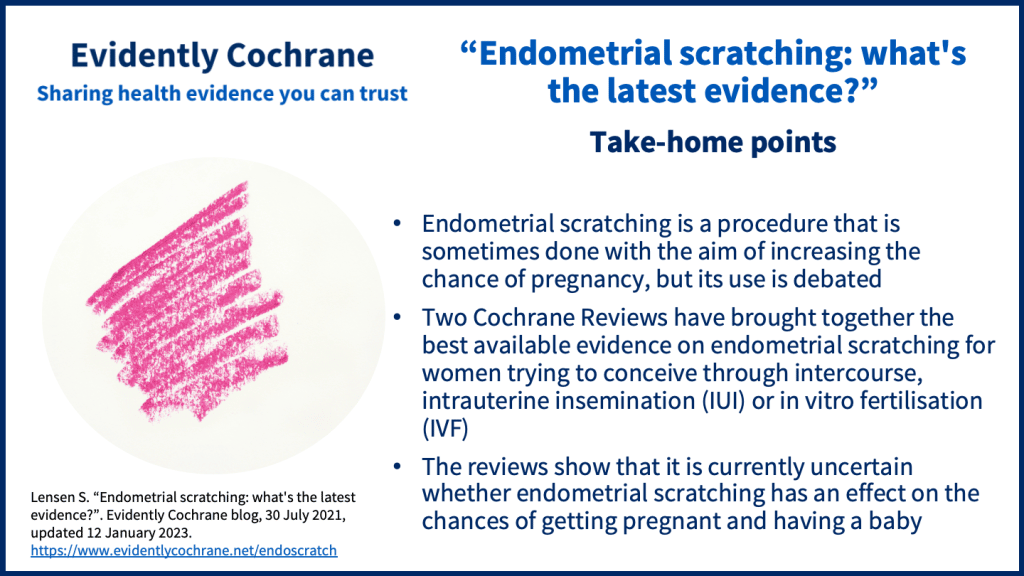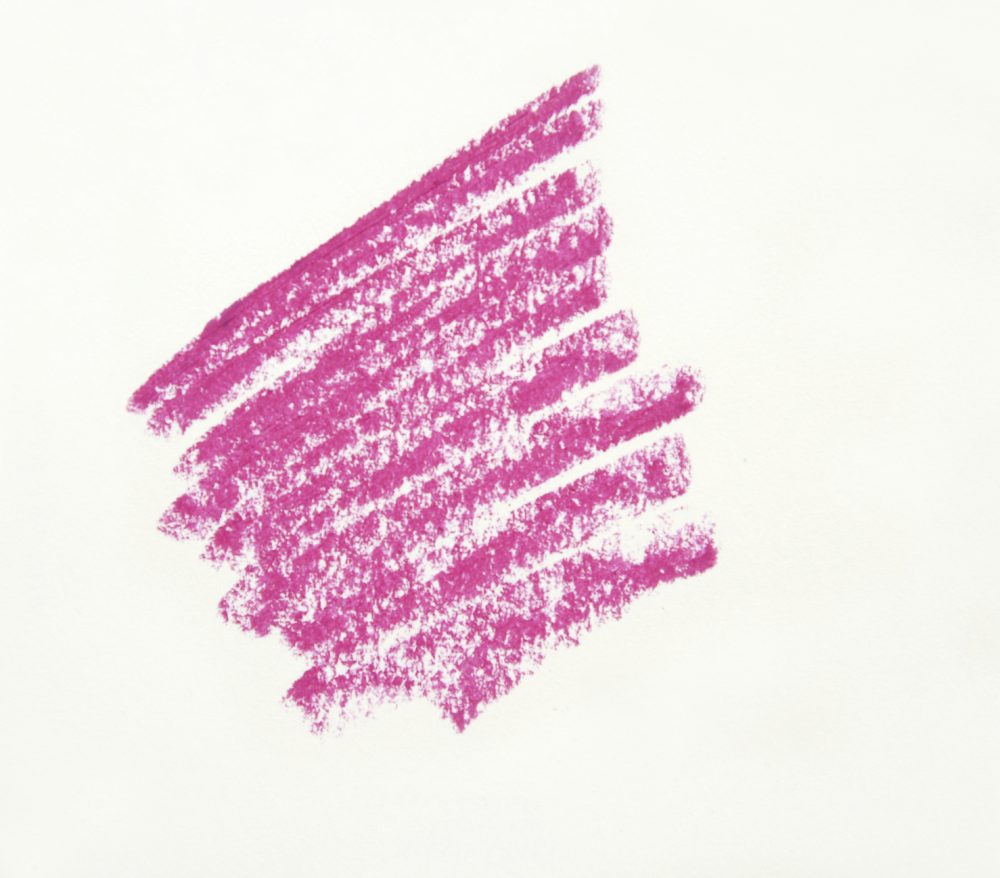In this blog, Sarah Lensen, one of the team who worked on the Cochrane ReviewsCochrane Reviews are systematic reviews. In systematic reviews we search for and summarize studies that answer a specific research question (e.g. is paracetamol effective and safe for treating back pain?). The studies are identified, assessed, and summarized by using a systematic and predefined approach. They inform recommendations for healthcare and research. on endometrial scratching (womb scratching), explains what the latest evidence tells us – and what we still don’t know.
Page last updated 12 January 2023.

Are you having trouble getting pregnant?
As many as 10% of couples experience subfertility, which is defined as the failure to conceive after at least one year of trying for a baby. You might have heard about a procedure called endometrial scratching. Some sources have suggested that this procedure can double the chances of getting pregnant. So what is endometrial scratching exactly, and does it really work?
There are a number of different reasons why some couples have difficulty conceiving. Assisted conception methods are available to help these couples get pregnant. These include simple methods such as medication to assist with ovulation, and insertion of sperm directly into the womb, also known as intrauterine insemination (IUI). In vitro fertilisation (IVF) is a more complicated process involving the collection of sperm and eggs for fertilisation in the laboratory, before the transfer of an embryo directly into the womb.
Endometrial scratching, also known as endometrial injury, is currently being suggested as a procedure to increase the probability of pregnancy in women and couples trying to conceive from intercourse, IUI or IVF, but the use of this procedure is still debated. We did two Cochrane Reviews on endometrial injury: one in women trying to get pregnant from sexual intercourse or intrauterine insemination Endometrial injury for pregnancy following sexual intercourse or intrauterine insemination (updated in October 2022) and one in women trying to get pregnant from IVF – Endometrial injury in women undergoing in vitro fertilisation (IVF) (updated in June 2021), to see if endometrial scratching helped these women conceive. Cochrane Reviews are internationally recognised as the highest standard of assessing healthcare interventions. They are a way of bringing together the results from multiple separate trialsClinical trials are research studies involving people who use healthcare services. They often compare a new or different treatment with the best treatment currently available. This is to test whether the new or different treatment is safe, effective and any better than what is currently used. No matter how promising a new treatment may appear during tests in a laboratory, it must go through clinical trials before its benefits and risks can really be known. in an unbiased way.
What is endometrial scratching?
The endometrium is a layer of tissue that lines the inside of the womb. In the first step of a pregnancy, an embryo will attach to the endometrium in a process called implantation. Endometrial scratching, also known as endometrial injury, is a procedure undertaken to purposely disrupt the endometrium in women wanting to get pregnant. It is thought this disruption may somehow increase the chance of an embryo implanting, and therefore creating a pregnancy.
Endometrial scratching can be done with many different instruments. The most common technique is the endometrial biopsy procedure, normally done with a thin flexible plastic tube, 3mm wide, called a pipelle catheter. The pipelle is inserted through the cervix (neck of the womb) into the womb, where it is moved back and forth and rotated in order to cause some disruption. This is the very same procedure a gynaecologist would use in order to get an endometrial sample for analysis, where it is called an endometrial biopsy.
The procedure has been re-purposed and re-named as endometrial scratching recently due to its potential use in the fertility area. It is a simple, low-cost procedure which can be done at an outpatient appointment, without anaesthetic, in just a few minutes. It can cause some discomfort or pain, and some bleeding. Risks of endometrial scratching include infection and uterine perforation, but these are very rare.
How might it work?
It is not clear what the biological process is that may lead to an increased probability of pregnancy. One theory is that endometrial scratching causes some sort of inflammatory response within the endometrium, similar to a scratch on any other part of the body. It may be that the wound healing response following the scratch improves the environment of the endometrium and makes it more likely for an embryo to implant and create a pregnancy.
The evidence for endometrial scratching
In women trying to get pregnant from sexual intercourse or intrauterine insemination (IUI)
This Cochrane Review (updated October 2022) only included randomised trials about endometrial scratching in women trying to get pregnant from intercourse or IUI.
This review included a total of 22 randomisedRandomization is the process of randomly dividing into groups the people taking part in a trial. One group (the intervention group) will be given the intervention being tested (for example a drug, surgery, or exercise) and compared with a group which does not receive the intervention (the control group). controlled trialsA trial in which a group (the ‘intervention group’) is given a intervention being tested (for example a drug, surgery, or exercise) is compared with a group which does not receive the intervention (the ‘control group’).. However, most of these suffered from serious methodological flaws and so the results of the review focussed on one studyAn investigation of a healthcare problem. There are different types of studies used to answer research questions, for example randomised controlled trials or observational studies. (210 women). These women had a condition known as polycystic ovarian syndrome, which had caused them to not ovulate, and were undergoing a procedure called laparoscopic ovarian drilling. The women were randomised to either undergo an endometrial scratch procedure at the time of their laparoscopy, or not.
Because only one small study was included, we are uncertain whether endometrial injury has an effect on the probability of getting pregnant or having a baby. The evidence suggests that if the chance of live birth is normally about 34%, then the chance with endometrial injury may be 27% to 55%. Even when we added back in the poor-quality studies, we are still uncertain whether endometrial injury helps, as the evidence was of such low quality it could not be relied upon.
It is important to also consider potential adverse events of this procedure (unwanted effects). Most often, mild to moderate pain was reported. Doctors recommending this procedure should balance any suggested benefit of endometrial injury against the potential risks. This is especially true if the procedure is performed in the second half of the menstrual cycle, where there is the potential to disturb an early pregnancy. Other factors include any cost or inconvenience to the patient.
In women trying to get pregnant from in vitro fertilisation (IVF)
This Cochrane Review included a total of 37 studies in women who were trying to get pregnant from IVF. Again, because many of the studies were methodologically flawed, the results focussed on eight studies which were of the best quality.
The effect of endometrial injury on the chance of getting pregnant and having a baby from IVF is unclear as the results are consistent with no effect, or a small reduction, or an improvement. The evidence suggests that if the chance of live birth with IVF is usually 27%, then the chance when using endometrial injury would be somewhere between less than 27% and 32%. When we added back in the poorer quality studies, the dataData is the information collected through research. was not able to be pooled together because the results from each study were so diverse.
In these studies, endometrial injury was also associated with mild to moderate pain (approximately 4 out of 10; with 10 being the most painful), and some minimal bleeding.
Where does this leave us?
A large number of randomised trials have been published on endometrial injury – but most of these have been poor quality and therefore the results are considered to be unreliable. Based on the evidence we have, we are uncertain whether endometrial injury has an effect on the chance of getting pregnant and having a baby. It is a somewhat painful procedure associated with a small amount of bleeding. Current evidence does not support the routine use of endometrial injury for women trying to conceive from sexual intercourse, IUI or IVF.
Find out more
- Read a blog about IVF add-ons: the latest Cochrane evidence
- Read more blogs about pregnancy and fertility
- Read more about the Cochrane Gynaecology and Fertility Group
Sarah Lensen has nothing to disclose.
Join in the conversation on Twitter with @CochraneUK @CochraneCGF or leave a comment on the blog.
Please note, we cannot give medical advice and do not publish comments that link to individual pages requesting donations or to commercial sites, or appear to endorse commercial products. We welcome diverse views and encourage discussion but we ask that comments are respectful and reserve the right to not publish any we consider offensive. Cochrane UK does not fact check – or endorse – readers’ comments, including any treatments mentioned.



I am interested in this research. However, I am worried about ethical issues